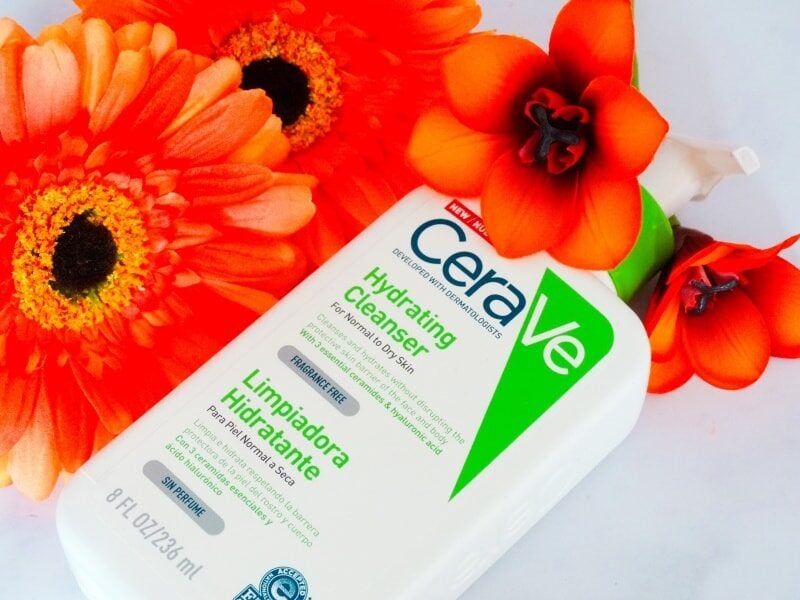“My skin is ALWAYS dry and flaky, no matter what I do.”
“I’m afraid of trying new skincare products. My skin’s so sensitive, it can’t tolerate ANYTHING!”
“Every time I wash my face, my skin feels so tight and dry.”
Sounds familiar? That’s your acid mantle screaming for help.
What Is The Acid Mantle?
Acid mantle is a cute nickname for hydro-liquid film, a protective layer that sits on the top of your skin. Think of it like a wall between you and the world.
It’s called acid because it’s sligtly acidic. It needs to be. That’s what makes your skin inhospitable to fungi and bacteria, so they don’t grow and multiply all over your skin.
Your acid mantle is made up of a mixture of oils and water. Here’s the full list:
- Amino acids
- Fatty acids
- Lactic acid
- Pyrrolidine carboxylic acid
- Urocanic acid
- Water
Put all these ingredients together and they create an acidic environment of around pH 4.5-5.5. That’s the natural pH of your skin.
Related: Why You Should Add Amino Acids To Your Skincare Routine
Struggling to put together a skincare routine that banishes dryness and makes your skin supple and dewy? Download your FREE “Best Skincare Routine For Dry Skin” to get started (it features product recommendations + right application order):
What The Heck Does The Acid Mantle Do?
Your acid mantle is your first line of the defence against everything that wants to hurt your skin.
It protects it from freezing cold winds, the blistering hot sun, bacteria and germs and all its other enemies. Plus, it keeps your skin soft and supple.
When your acid mantle’s intact, moisture stay in and germs & co stay out. Your skin is healthy, soft and resistant (it tolerates everything).
Problem is, the acid mantle is ALWAYS under attack. A dent here today, a knock there tomorrow and pretty soon your acid mantle breaks down all over the place.
Now moisture escapes through the cracks. Germs & bacteria get a free way in. Your skin gets dry. Red. Flaky. Everything stings and irritates it like crazy.
Here are just a few things that can damage your acid mantle:
- Air conditioning
- Harsh skincare products, like scrubs and soaps
- Harsh weather
- Overcleansing
- Overexfoliating
- Pollution
- Skin diseases like eczema
- Unprotected sun exposure
Related: 5 Skincare Treatments That Can Ruin Your Skin (If You Abuse Them)

How To Repair Your Acid Mantle
First of all, how can you tell your acid mantle is damaged?
Easy. If your skin feels tight after washing, is always dry and everything you put on it irritates it like crazy, the damage’s done. Your acid mantle needs fixing. Here’s how:
Step 1: Switch Cleanser
Bad news: everything you could possibly use to wash your skin can damage your skin’s acid mantle.
Take water, the most natural and innocuous thing on this planet. It has a pH of 7. Wash your face with water alone and you’ll turn your skin’s pH up a notch or two. Acid mantle damaged.
Good news: your skin is perfectly capable of restoring its acidic pH (and restore the acid mantle) on its own. Usually within a few hours.
Problem is, some cleansers are SO harsh, and you use them so often, your skin’s acid mantle can’t repair itself fast enough. Cue dryness, flakiness and irritation.
Soaps and foaming cleansers are the biggest culprits. Switch to gentle, cream or oil-based cleansers enriched with fatty acids, ceramides and other barrier-repairing ingredients that cleanse skin without destroying the acid mantle.
Best Picks:
- CeraVe Hydrating Cleanser ($14.99): available at Dermstore, Feel Unique, Ulta and Walmart
- La Roche Posay Toleriane Dermo-Cleanser ($23.99): available at Dermstore and Feel Unique
- Paula’s Choice Calm Redness Relief Cleanser Normal To Dry ($18.00): available at Feel Unique and Paula’s Choice
Related: Why You Should Stop Washing Your Face With Soap
Step 2: Give Exfoliation A Break
I’m all for exfoliation: it brightens up your skin, fades away fine lines and dark spots and makes your skin as soft as a baby’s. But when your acid mantle is damaged, exfoliation is the LAST thing your skin needs.
All those dead cells on the surface of your skin are there for a reason: they protect the raw, newer cells that aren’t ready to come to the surface yet.
Your skin’s very delicate right now and needs all the protection it can get. So give exfoliation a break or, at least, go easier on it.
While we’re on the subject: stop using 3+ exfoliants in your skincare routine (thanks, The Ordinary!). Too much exfoliation disrupts the skin’s acid mantle, too.
Related: Is Exfoliation For Everyone?

Step 3: Go Back To Basics
Stop everything you’re doing with your skin. Give exfoliation a break. Ditch the retinol. Go easy on Vitamin C. I know you want to get rid of wrinkles, but this ain’t no time to think about antiaging.
When your skin’s acid mantle is damaged, fixing it is the priority. And that means getting rid of everything that could possibly irritate it. Like soaps, foaming cleansers and exfoliants. But also powerful antioxidants, fragrances and any other irritants lurking in your lotions and potions.
Instead, go back to basic: a gentle cleanser, plus moisturiser and sunscreen full of soothing and moisturising ingredients that can repair your skin’s barrier and keep its pH back to its optimum level.
The best products are loaded with ceramides, fatty acids and non-fragrant oils (think jojoba instead than geranium). They’re all naturally found in your skin so can help bring it back to health. Fast.
Best picks:
- CeraVe Moisturizing Lotion ($13.99): available at Dermstore and Walmart
- The Ordinary Natural Moisturising Factors + HA ($6.80): Beauty Bay, Cult Beauty and Feel Unique
The Bottom Line
If your skin’s dry, irritated and sensitive all the time, your acid mantle is damaged. That’s your cue to go back to basics with your skincare. Throw out anything remotely irritant and moisturise, moisturise, moisturise.



In a case where disease conditions like eczema destory your acid mantle what skin product can be used to repair the acid mantle.
In a case of a baby what skin product can be use to repair the acid mantle.
Philomina, try an oil like jojoba or squalane. They’re almost identical to human sebum so unlikely to cause any negative reaction.
Hi Gio, thanks for this post. It’s my experience that moisturizers delay the skin’s natural restoration of the acid mantle. Ideally, a healthy acid mantle itself draws moisture in and keeps it in, right? So how can we stop the addiction to moisturizer and repair the acid mantle at the same time? Thanks!
Lise, why do you think that moisturisers delay the skin’s natural restoration of the acid mantle? On the contrary, a properly formulated moisturiser helps speed it up. It’s only when your moisturiser contains harsh actives like retinol or irritating ingredients like fragrance, that you’re compromising the acid mantle more.
Hi Gio, in the case that the acid mantle is disrupted causing acne and irritation, will the moisturizing exacerbate the acne? I’m afraid to use moisturizers because I’m afraid my oil production will go haywire causing more breakout. Excessive oil production was the original reason why I have over exfoliated wrecking my acid mantle. Any help will truly be appreciated. Thank you!
T, as long as you use an oil-free moisturiser like CeraVe PM lotion, you shouldn’t experience breakouts.
Hi Gio, when the acid mantle is disrupted does it help touse oils or serum or moisturiser with omega fatty acid? Thank you
Oh and I have also an other question. So it is okay to wash your face with just water or it would be better to use the gentle cleanser?
Hi Gio, do the use of oils (like Argan or jojoba) help to restore the acid mantle? And in case of damaged acid mantle is better to was the face just with water or with a gentle cleanser? Thank you!
Lina, yes you can use oils to restore the acid mantle. I recommend gentle facial cleansers for this. You can find my fave in the post. It’s all clearly explained above. 🙂